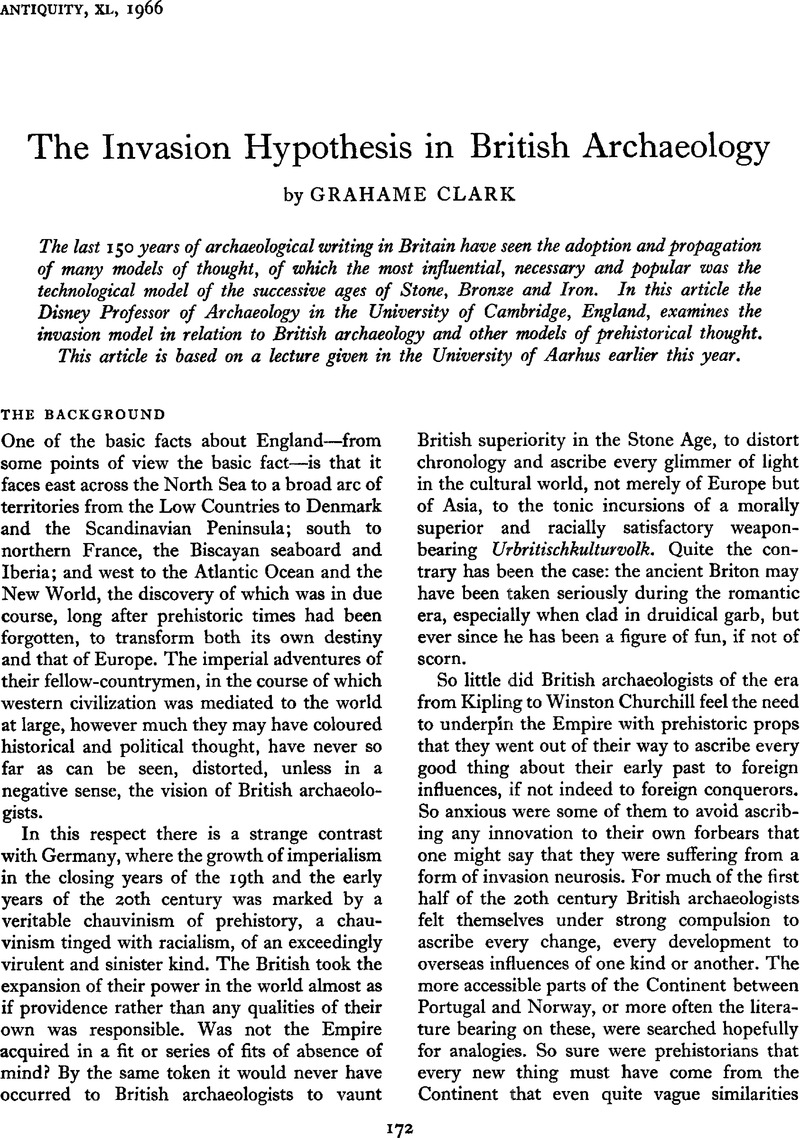Crossref Citations
This article has been cited by the following publications. This list is generated based on data provided by
Crossref.
Newton, R. G.
and
Renfrew, Colin
1970.
British Faience Beads Reconsidered.
Antiquity,
Vol. 44,
Issue. 175,
p.
199.
Renfrew, Colin
1970.
The Autonomy of the South-East European Copper Age.
Proceedings of the Prehistoric Society,
Vol. 35,
Issue. ,
p.
12.
Latorre-Ruiz, Juan
1970.
Koch, J. T.; Cunliffe, B. (Eds.) (2016): "Celtic from the West 3: Atlantic Europe in the Metal Ages: questions of shared language". Oxbow Books, Oxford..
Complutum,
Vol. 28,
Issue. 1,
p.
231.
Nicklin, Keith
1971.
Stability and innovation in pottery manufacture.
World Archaeology,
Vol. 3,
Issue. 1,
p.
13.
Daniel, Glyn
1971.
From Worsaae to Childe: The Models of Prehistory.
Proceedings of the Prehistoric Society,
Vol. 37,
Issue. 2,
p.
140.
HICKS, SHEILA P.
1971.
POLLEN‐ANALYTICAL EVIDENCE FOR THE EFFECT OF PREHISTORIC AGRICULTURE ON THE VEGETATION OF NORTH DERBYSHIRE.
New Phytologist,
Vol. 70,
Issue. 4,
p.
647.
Gibbon, Guy E.
1972.
Cultural Dynamics and the Development of the Oneota Life-Way in Wisconsin.
American Antiquity,
Vol. 37,
Issue. 2,
p.
166.
Sankalia, H. D.
1973.
Prehistoric colonization in India.
World Archaeology,
Vol. 5,
Issue. 1,
p.
86.
Guilbert, G. C.
1975.
Planned Hillfort Interiors.
Proceedings of the Prehistoric Society,
Vol. 41,
Issue. ,
p.
203.
Dennell, R. W.
1976.
Prehistoric Crop Cultivation in Southern England: A Reconsideration.
The Antiquaries Journal,
Vol. 56,
Issue. 1,
p.
11.
Renfrew, Colin
1978.
Trajectory Discontinuity and Morphogenesis: The Implications of Catastrophe Theory for Archaeology.
American Antiquity,
Vol. 43,
Issue. 2,
p.
203.
ROBERTSHAW, P. T.
1978.
The Origin of Pastoralism in the Cape.
South African Historical Journal,
Vol. 10,
Issue. 1,
p.
117.
RENFREW, COLIN
and
POSTON, TIM
1979.
Transformations.
p.
437.
Attenborough, Robert
1986.
The Movement Of People And The Adoption Of Other Cultures: the neodiffusionism of Ammerman and Cavalli-Sforza.
Canberra Anthropology,
Vol. 9,
Issue. 1,
p.
102.
Fowler, Don D.
1987.
Uses of the Past: Archaeology in the Service of the State.
American Antiquity,
Vol. 52,
Issue. 2,
p.
229.
Wells, Peter S.
1989.
Cross-Cultural Interaction and Change in Recent Old World Research.
American Antiquity,
Vol. 54,
Issue. 1,
p.
66.
Roberts, B.K.
1990.
Historical Geography of England and Wales.
p.
1.
CHAMPION, TIMOTHY
1990.
Migration Revived.
Journal of Danish Archaeology,
Vol. 9,
Issue. 1,
p.
214.
Russell, Lynette
and
McNiven, Ian J.
1998.
Monumental Colonialism.
Journal of Material Culture,
Vol. 3,
Issue. 3,
p.
283.
Needham, Stuart P.
2000.
Power Pulses Across a Cultural Divide: Cosmologically Driven Acquisition Between Armorica and Wessex.
Proceedings of the Prehistoric Society,
Vol. 66,
Issue. ,
p.
151.





